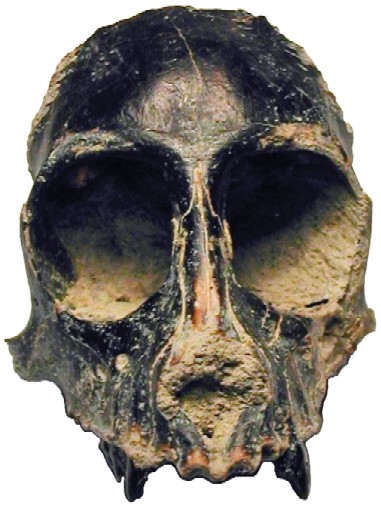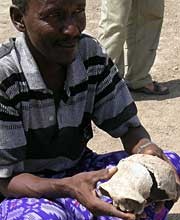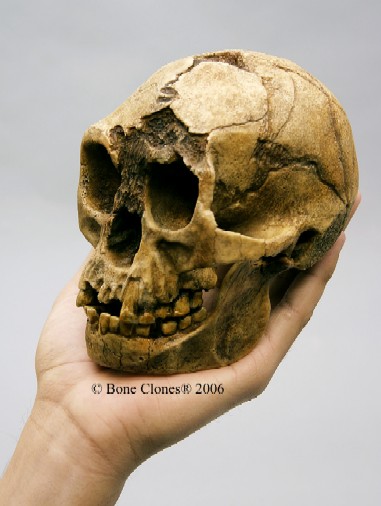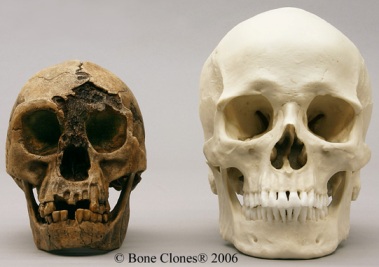New Little Skulls
Posted by: Loren Coleman on March 30th, 2006
A new species of monkey discovered in South America, larger than contemporary monkeys? A new hominid species found, perhaps as a link between erectus and sapiens?
Two recent new fossil skull finds may have much to tell cryptozoology, as they become more deeply understood.
A team of Argentinean and United States scholars have identified a new species of monkey that once roamed the rainforests of Patagonia, South America. The discovery of the monkey species, Killikaike blakei, was announced by Brooklyn College Associate Professor of Anthropology and Archaeology Alfred L. Rosenberger.
The discovery, dated to 16.4 million years ago, was of a small, perfectly preserved monkey skull (pictured below) from a young female, which was found embedded in volcanic rock by members of an Argentinean ranching family. It is an excellent addition to the scant fossil record of New World monkeys because of its pristine condition. The results are published in the Proceedings of the National Academy of Science.

The skull of Killikaike blakei, a newly identified prehistoric monkey from South America.
Meanwhile, on the near human skull front, our ears were perked up reading that a "little skull" was recently discovered that might point to a link between Homo erectus and Homo sapiens. Of course, the media loves the almost legendary "missing link" type story, so it has been surprising to see this one downplayed in the American press.
This new hominid cranium (shown below) was found in two pieces three weeks ago at Gawis in Ethiopia’s northeastern Afar region. It is believed to be between 500,000 and 250,000 years old.

"A good fossil provides anatomical evidence that allows us to refine our understanding of evolution. A great fossil forces us to re-examine our views of human origins. I believe the Gawis cranium is a great fossil," said Scott Simpson, a project paleontologist from Case Western Reserve University School of Medicine at Cleveland, Ohio, told CNN.
"This is really exciting because it joins a limited number of fossils which appear to be evolutionary between Homo erectus and our own species Homo sapiens," said Eric Delson, a paleoanthropologist at Lehman College of the City University of New York.
Every new "little skull" discovered will be a cause for some attention after the outstanding find of Homo floresiensis, which certainly speaks to new fossils giving us significant candidate information for our cryptozoological pursuits.

Homo floresiensis skull replica available from Bone Clones.

About Loren Coleman
Loren Coleman is one of the world’s leading cryptozoologists, some say “the” leading living cryptozoologist. Certainly, he is acknowledged as the current living American researcher and writer who has most popularized cryptozoology in the late 20th and early 21st centuries.
Starting his fieldwork and investigations in 1960, after traveling and trekking extensively in pursuit of cryptozoological mysteries, Coleman began writing to share his experiences in 1969. An honorary member of Ivan T. Sanderson’s Society for the Investigation of the Unexplained in the 1970s, Coleman has been bestowed with similar honorary memberships of the North Idaho College Cryptozoology Club in 1983, and in subsequent years, that of the British Columbia Scientific Cryptozoology Club, CryptoSafari International, and other international organizations. He was also a Life Member and Benefactor of the International Society of Cryptozoology (now-defunct).
Loren Coleman’s daily blog, as a member of the Cryptomundo Team, served as an ongoing avenue of communication for the ever-growing body of cryptozoo news from 2005 through 2013. He returned as an infrequent contributor beginning Halloween week of 2015.
Coleman is the founder in 2003, and current director of the International Cryptozoology Museum in Portland, Maine.










Loren
Do you think that the Homo floresiensis Skulls maybe related in anyway to the New Little Skulls?